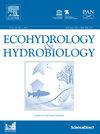The synergistic effect of abiotic microbes in a standardized aquaponics system for the production of high-value fish and plant biomass
IF 2.2
4区 环境科学与生态学
Q2 ECOLOGY
引用次数: 0
Abstract
Aquaponics is an attempt to control water quality such that all living beings (fish, plants, and bacteria) can live. In this study, the tilapia fish, Oreochromis niloticus, and the plants, mustard (Brassica nigra) and millet (Pennisetum glaucum), were raised in a low-cost aquaponics system (Nutrient Film Technique or NFT). The study also examined the microbial load and various water quality parameters. According to the USEPA rules, the water quality attributes of NFT have to be stable. During different culture periods, the growth rate of fish in the NFT system was gradually increased significantly (p < 0.01). The ANOVA analysis revealed that the recorded biochemical-values of NFT-raised fishes were less significant (p < 0.04) (than control fishes). When compared to the NFT-grown mustard plant, the biochemical content of NFT-raised millet plant was significantly lower (p < 0.003). Currently, the phytochemical content has been found to be high in NFT grown plants. Chlorophyll 'a' level was high (8.17 mg) in NFT and low (2.34 mg) in controls. The maximum chlorophyll 'b' level in plants produced using NFT was 8.45 mg, whereas the lowest (0.84 mg) was recorded in control plants. Carotenoid concentration was high (707 mg) in plants cultivated using NFT, but low (239 mg) in control plants. Furthermore, when compared to the control (24 colonies), the NFT produced the greatest number of microbial colonies (57 colonies) at 10−4dilution. Thus the adoption of NFT techniques shows its usefulness in terms of reduced cost and water usage and the reduction in microbial load (when fish and plants are raised together). Therefore, this research-output supports the potential of NFT-technology as an integrated aquaculture approach for future.
标准化鱼菜共生系统中非生物微生物对生产高价值鱼类和植物生物量的协同效应
鱼菜共生是一种控制水质的尝试,使所有生物(鱼、植物和细菌)都能生存。在本研究中,罗非鱼(Oreochromis niloticus)、芥菜(Brassica nigra)和谷子(Pennisetum glaucum)在低成本的水共生系统(营养膜技术或NFT)中饲养。研究还检测了微生物负荷和各种水质参数。根据美国环保署的规定,NFT的水质属性必须是稳定的。在不同的培养时期,NFT系统中鱼类的生长速度逐渐显著提高(p <;0.01)。方差分析显示,nft养殖鱼类的生化值记录不显著(p <;0.04)(比对照鱼)。与nft栽培的芥菜植株相比,nft栽培的谷子植株的生化含量显著降低(p <;0.003)。目前已发现NFT种植的植物中植物化学成分含量较高。NFT组叶绿素a含量高(8.17 mg),对照组低(2.34 mg)。NFT处理植株叶绿素b含量最高为8.45 mg,对照植株最低为0.84 mg。NFT栽培植株类胡萝卜素浓度高(707 mg),对照植株类胡萝卜素浓度低(239 mg)。此外,与对照(24个菌落)相比,在10−4稀释时,NFT产生的微生物菌落数量最多(57个菌落)。因此,采用NFT技术显示其在降低成本和用水量以及减少微生物负荷(当鱼和植物一起饲养时)方面的有用性。因此,这项研究成果支持了nft技术作为未来综合水产养殖方法的潜力。
本文章由计算机程序翻译,如有差异,请以英文原文为准。
求助全文
约1分钟内获得全文
求助全文
来源期刊

Ecohydrology & Hydrobiology
Agricultural and Biological Sciences-Aquatic Science
CiteScore
5.40
自引率
3.80%
发文量
51
期刊介绍:
Ecohydrology & Hydrobiology is an international journal that aims to advance ecohydrology as the study of the interplay between ecological and hydrological processes from molecular to river basin scales, and to promote its implementation as an integrative management tool to harmonize societal needs with biosphere potential.
 求助内容:
求助内容: 应助结果提醒方式:
应助结果提醒方式:


